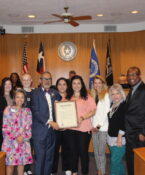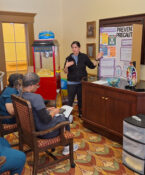Researchers receive $45 million federal grant to study health disparities in Alzheimer’s disease


Researchers at HSC Fort Worth were awarded a grant expected to total $45 million from the National Institute on Aging, part of the National Institutes of Health, to expand innovative research into Alzheimer’s disease and the biological differences that cause the disease to disproportionately afflict Mexican Americans.
The 5-year research grant, awarded to Sid O’Bryant, PhD, Professor and Executive Director of the Institute for Translational Research, and Leigh Johnson, PhD, Associate Professor and Associate Director, is the largest research award ever received by The University of North Texas Health Science Center at Fort Worth.
“This is a transformative award for our university,” HSC President Dr. Michael Williams said. “HSC is recognized as a national leader in the quest to unlock the mysteries of Alzheimer’s disease and to discover new interventions to help prevent this deadly disease.”
Drs. O’Bryant and Johnson seek to understand the biological framework of Alzheimer’s disease in multi-ethnic populations and how it differs from that of non-Latino whites. For example, Mexican Americans develop Alzheimer’s disease 10 years earlier than whites. However, most of the Alzheimer’s research focuses on Non-Latino whites.
Alzheimer’s Research
First-of-its-kind research is underway at HSC to detect Alzheimer’s disease earlier and develop new treatments. We need your support to make it happen.
The new funding will build off the HABLE study, a five-year project at HSC that Dr. O’Bryant started in 2017 and is funded by a $12 million National Institutes of Health grant. Almost 1,000 Mexican Americans and 1,000 non-Latino whites over 50 from North Texas have enrolled in the study into how different biological causes relate to Alzheimer’s disease across ethnicities.
HABLE participants undergo free comprehensive interviews, functional exams, clinical laboratory tests, a brain MRI and more.
With the new funding HSC will create a state-of-the-art imaging center in the Institute for Translational Research where the ITR team will perform two PET Scans on every HABLE participant to look for beta amyloid or tau proteins, which are biomarkers for Alzheimer’s. Two years later, each participant will undergo two more PET Scans for comparison of how the proteins have progressed.
The scans will allow researchers to observe the differences in Mexican Americans and non-Latino whites. Preliminary data suggests that beta amyloid protein differs significantly in prevalence between the two ethnicities, Dr. O’Bryant said.
“This is the first of its kind, large-scale, longitudinal study of the biological framework of Alzheimer’s in community-dwelling and multi-ethnic populations,” Dr. O’Bryant said. “We know from looking at new treatments for cancer and diabetes that understanding the biology of the disease is critically important to the development of novel, effective therapeutic interventions.”
Mexican Americans represent the fastest growing aging population in the country. It is estimated that 1 million Mexican Americans will be diagnosed with Alzheimer’s Disease by 2030.
While novel interventions may be years away, HABLE program participants may benefit immediately from medical information gathered. Participants can request the results of the comprehensive medical exams are shared with their health care providers to help guide their current medical decisions.
Because the new imaging center where participants will undergo PET scans is on the HSC campus, the HABLE project team won’t have to refer participants out to private imaging centers for the valuable but costly scans.
“Very few laboratories in the county will have the imaging capability that the Institute for Translational Research will have at HSC,” Dr. O’Bryant said.
All data recorded through the study will be shared publicly with the scientific community throughout the duration of the project to aid other investigators in their quest for Alzheimer’s breakthroughs, Dr. Johnson said.
Dr. O’Bryant also is overseeing the first study of a blood test to detect Alzheimer’s disease within a primary care setting. That study underway at HSC, is funded by a separate $6.5 million study funded by NIA.
The HABLE projects are funded by NIA grants R01AG058533-01A1 and R01AG054073.



![Uyen Sa Nguyen Scaled[58]](https://www.unthsc.edu/newsroom/wp-content/uploads/sites/16/Uyen-Sa-Nguyen-scaled58-145x175.jpg)

Social media